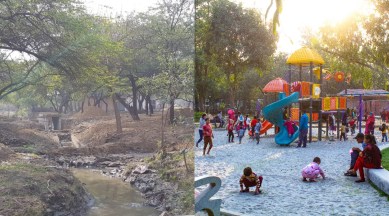Stay updated with the latest - Click here to follow us on Instagram
How Delhiites came together to revive a park
Vasant Udyaan, which was riddled with multiple issues, from encroachment and security concerns to lack of toilets for the slum cluster nearby and raw sewage, which made the air toxic, was a space waiting to be reclaimed.

This is a story about how civic action, political will and fighting a common enemy, won a public space for the people of Delhi. Not so long ago, the DDA District Park and forest land adjoining the Basant Lok Market lay in decrepit wilderness, from open nallahs and a dilapidated Tughlak-era monument to becoming a crime hotspot with murder and drug-peddling cases making headlines. Today, the 43 acres have been transformed to become a public park that has close to 2,000 users a day. Visitors, young and old, have made the space their own. If in a corner one sees children from the nearby slum playing cricket, there are tik-tok-ers making videos, senior citizens out for a stroll, friends catching up and employees from nearby shops taking a work break.
But this renewal did not happen in a day. Telling this story is a book, “The Garden of Pride: Project Vasant Udyaan”, published by Citizen Action for Water Sustainability, which was released at the India International Centre on November 1.
monthly limit of free stories.
with an Express account.
It all began in 2015-16, when a group of concerned residents of Munirka Enclave stepped out of their comfort zone to reclaim their neighbourhood. The park, which was riddled with multiple issues, from encroachment and security concerns to lack of toilets for the slum cluster nearby and raw sewage, which made the air toxic, was a space waiting to be reclaimed.
“In 2003 when I came to the area, I would go for my morning walks to the park. There were only cows and pigs for company. There was no walking track or security,” says Gurpreet Singh Bindra, president, RWA, Vasant Vihar. However, today as one walks into Vasant Udyaan, it is the proverbial turning a new leaf. There are walkways, decks, an amphitheatre, a poetry corner and ample lighting in the evenings to make the park safe and accessible.
Senior NDTV journalist, Sunil Prabhu, who has an interest in horticulture, gathered members of his RWA to review the neighbourhood. He had already led initiatives in greening his own colony using sewage-treated water from Jaypee Vasant Continental next door, had put into action rainwater harvesting and compositing, along with other residents. But the park renewal was a sleeping monster. With his core team of RWA members, he began knocking on doors, from government agencies such as the DDA, SDMC, DUSIB, Delhi Jal Board, INTACH, ASI, to meeting other neighbourhood RWAs and private players such as the hotel and the Basant Lok Market Association.
“The entire process to green Munirka Enclave and Munirka Vihar through Jaypee hotel and SDMC taught us that our fundamental need was water. We got drip irrigation systems in place to save water yet keep the soil moist. When we began surveying the park, we resulted much of the forest area had eroded. There was a huge Sewage Treatment Plant (STP) that lay defunct. We decided to make this project a multiple stakeholder initiative. Then there were the jhuggi clusters, as well. While we did not want to build a wall, we wanted to include them in some way. With DUSIB on board, we built toilets, which stymied the encroachment and helped remove sewage waste. This gave the slum dwellers an entry for participation and a sense of ownership. We also activated the STP. It wasn’t easy, trying to get those in civic maintenance to help us. With the support of former Lieutenant Governor Anil Baijal, DDA took up the project. The park is not ticketed so you will see every demographic and strata of people here. It’s important for cities to curate public spaces for all, not just have malls which are like bubbles, with limited access,” says Lora Prabhu, Director-Co-founder, Centre for Equity and Inclusion (CEQUIN).
In the book, women from the jhuggies testify that their income has increased because they can take on more work, on both sides of the park – Vasant Vihar and Munirka — since it is now a shortcut for them. “One never knew cleaning up a patch of land could have such a ripple effect,” adds Lora.
More than the built parts of the park, what lies hidden is fundamentally more important. “What I find fascinating is the incremental process in this project, which was a step-by-step action plan, how it created a stake for every person and developed into a larger common goal, of conserving water and having a safe public place. It’s an understanding that all our fates are interlinked, be it through water and waste management or security. This is a very different project from a Sundar Nursery or a Lodhi Garden,” says Avinash Kumar, Distinguished Fellow, Centre for Equity Studies, who is an advisor for the project, over the last year.
Even as DDA is maintaining the park, the RWAs aren’t letting go. They are keeping tab and fixing broken systems, be it the pipe connections or CCTV recordings.